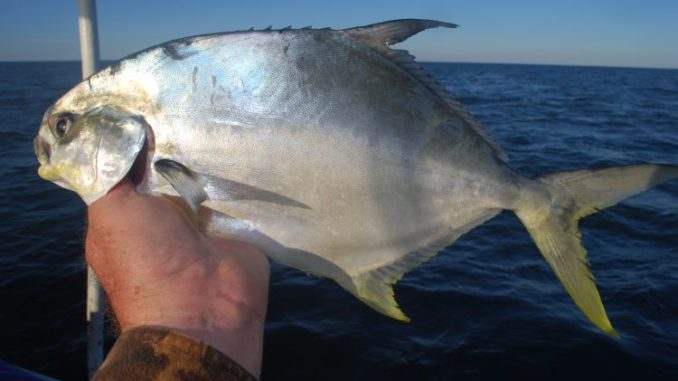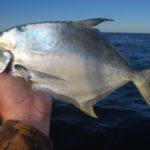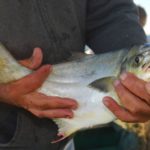
Some fish are work horses: They’re strong and can pull heavy loads all day. That’s a redfish. Others are race horses. They are sleek and fast, but poop out quickly — that’s a speckled trout.
But a few are glamour fish. They are elegant; they have grace and speed; they are attractive; they have good taste — er, they taste good. Such would be the case for the Florida pompano, simply called pompano in Louisiana.
McFadden Duffy, the late, great outdoors writer for the Louisiana Conservationist magazine, called it “a prince among game fish” in a 1961 article. He wasn’t ashamed to admit that he was quite taken with the fish. To him, its delightful table qualities were secondary to the challenge of catching the picky creature.
Pompano belong to the large jack family. Twenty-nine members of the family swim the U.S. waters of the Atlantic and Gulf of Mexico. They range from the runty little Atlantic bumper to the bruising greater amberjack; from the bloodily inedible crevalle jack to the scrumptious Florida pompano.
Identifying pompano
Florida pompano are attractive fish, shading from blue-greenish silver on their backs to silver on their sides to canary yellow on their bellies. The only other fish that it can be confused with are permit and crevalle jacks.
Young jack crevalles (as we call them, reversing the names) under 12 inches long share the bright yellow colors of pompanos and are found in the surf zone, where pompano hang out.
They are easy to separate though. Jack crevalles have a row of enlarged raised scales called scutes along each side of their bodies just ahead of their tails. Neither pompanos nor permits have these.
Permit are uncommon in Louisiana waters, although they turn up once in a while. Viewed from the side, their bodies are almost round in shape, while a pompano is slightly elongated. They also share very little of the yellow coloration that is found on pompano.
Permit grow large, up to 60 pounds. The IGFA world record pompano is 8 pounds, 4 ounces. Strangely, Louisiana’s all-time record is larger, an 8-pound, 8-ounce fish caught in 1969.
That eight of the other top 10 fish were caught between 1970 and 1979, with only one pompano caught in 1986, shows just how far the fish has fallen off the radar screens of recreational fishermen in the last 30 years.
Where to find pompano
Pompano are found on the Atlantic coast from Cape Cod, Massachusetts in the north down through the Gulf of Mexico, to the South American coast well into Brazil.
Pompano have been recorded in waters 246 feet deep, but are really a coastal fish, reaching peak abundance in sand or mud-bottomed coastal bays and lakes, and sandy beach waters.
Their movements are triggered by changes in water temperatures, and to a lesser degree salinity. They may be found in waters from 63º to 90º F, but their preferred temperatures are above 82 degrees. Water temperatures below 50º F will kill them.
They are a distinctly saltwater fish, avoiding even brackish water. Preferred salinities are 28 to 37 parts per thousand (35 ppt is considered full strength sea water), although young fish can tolerate lower salinities.
During the summer, juvenile and adult pompano are common in the waters of beaches and passes. In September and October, the adults move inshore and stay there until falling water temperatures in November and December move them offshore, where they spend the winter.
Spawning and food preferences
Pompano have never been observed spawning, but from the presence of newly hatched larvae and spawned out adults, spawning is assumed to take place offshore with peaks from April to June and during September-October. Females as small as 10 inches long have been found filled with eggs.
They grow quickly. Youngsters grow 1 to 2 inches a month. Adults grow an average of 1.4 inches per month, with females growing faster and reaching larger sizes than males. The average pompano life span is 3 to 4 years, with a few fish living more than seven years.
Young fish have small cone-shaped teeth that disappear by the time they grow to 8 inches long. From then on, they have no teeth in their jaws or on their tongue. They use hard plates in their throats to crush their prey.
Pompano have a blunt nose and an underslung mouth. But the mouth is protrusible, meaning it can be extended outward, almost like a short tube.
The location of the mouth is ideal for their feeding habits. Large schools of pompano will cruise over the bottom, nose into the sand or mud, hunting for their preferred food items, which include small clams and mussels, shrimp, beach fleas and even smaller crustaceans, as well as small fish.
Pompano are best known for the delectable table qualities. Duffy put it perfectly in his 1961 article.
“As a food fish, there is none better than the pompano, either in the fresh waters or the sea. This is practically the unanimous verdict of epicures and all others who have had the pleasure of eating pompano, fresh from the water or quickly cleaned and processed for the freezer. The flesh is firm and rich, and possesses a delicacy of flavor peculiarly pleasing to the palate.”




